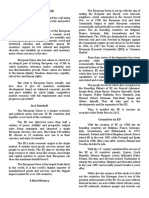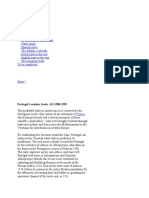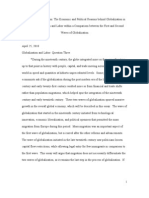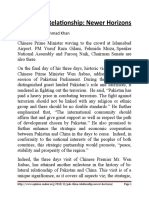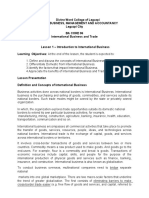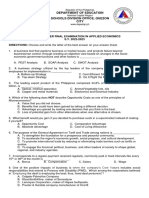100%(1)100% found this document useful (1 vote)
87 viewsHistory of Trade
History of Trade
Uploaded by
davidThe history of international trade chronicles notable events that have affected trade between countries over long distances. In ancient times, Mesopotamia served as an intermediary in the trade of goods like lapis lazuli between regions. The Assyrians established merchant colonies in Anatolia between 2000-1750 BC. In medieval times, the Hanseatic League secured trading privileges in England in 1157 and the Ottomans controlled spice routes through the Red Sea and Persian Gulf in the 16th century. In modern times, European powers like Portugal, the Dutch, and British vied for control of Asian trade networks and resources, sparking conflicts like the Opium Wars between Britain and China in the 1840s. After World
Copyright:
© All Rights Reserved
Available Formats
Download as PDF, TXT or read online from Scribd
History of Trade
History of Trade
Uploaded by
david100%(1)100% found this document useful (1 vote)
87 views21 pagesThe history of international trade chronicles notable events that have affected trade between countries over long distances. In ancient times, Mesopotamia served as an intermediary in the trade of goods like lapis lazuli between regions. The Assyrians established merchant colonies in Anatolia between 2000-1750 BC. In medieval times, the Hanseatic League secured trading privileges in England in 1157 and the Ottomans controlled spice routes through the Red Sea and Persian Gulf in the 16th century. In modern times, European powers like Portugal, the Dutch, and British vied for control of Asian trade networks and resources, sparking conflicts like the Opium Wars between Britain and China in the 1840s. After World
Original Title
history of trade
Copyright
© © All Rights Reserved
Available Formats
PDF, TXT or read online from Scribd
Share this document
Did you find this document useful?
Is this content inappropriate?
The history of international trade chronicles notable events that have affected trade between countries over long distances. In ancient times, Mesopotamia served as an intermediary in the trade of goods like lapis lazuli between regions. The Assyrians established merchant colonies in Anatolia between 2000-1750 BC. In medieval times, the Hanseatic League secured trading privileges in England in 1157 and the Ottomans controlled spice routes through the Red Sea and Persian Gulf in the 16th century. In modern times, European powers like Portugal, the Dutch, and British vied for control of Asian trade networks and resources, sparking conflicts like the Opium Wars between Britain and China in the 1840s. After World
Copyright:
© All Rights Reserved
Available Formats
Download as PDF, TXT or read online from Scribd
Download as pdf or txt
100%(1)100% found this document useful (1 vote)
87 views21 pagesHistory of Trade
History of Trade
Uploaded by
davidThe history of international trade chronicles notable events that have affected trade between countries over long distances. In ancient times, Mesopotamia served as an intermediary in the trade of goods like lapis lazuli between regions. The Assyrians established merchant colonies in Anatolia between 2000-1750 BC. In medieval times, the Hanseatic League secured trading privileges in England in 1157 and the Ottomans controlled spice routes through the Red Sea and Persian Gulf in the 16th century. In modern times, European powers like Portugal, the Dutch, and British vied for control of Asian trade networks and resources, sparking conflicts like the Opium Wars between Britain and China in the 1840s. After World
Copyright:
© All Rights Reserved
Available Formats
Download as PDF, TXT or read online from Scribd
Download as pdf or txt
You are on page 1of 21
History of Trade
The history of international trade chronicles notable events that have
affected the trade between various countries.
In the era before the rise of the nation state, the term 'international'
trade cannot be literally applied, but simply means trade over long
distances; the sort of movement in goods which would represent
international trade in the modern world.
In the 21st century, the European Union, United States and China are
the three largest trading markets in the world
ANCIENT
Indus–Mesopotamia relations are thought
to have developed during the second half
of 3rd millennium BCE, until they came to a
halt with the extinction of the Indus valley
civilization after around 1900 BCE.
Mesopotamia had already been an
intermediary in the trade of lapis lazuli
between South Asia and Egypt since at
least about 3200 BCE, in the context of
Egypt-Mesopotamia relations.
Assyrian merchant colony at Kanesh in Cappadocia.
Between 2000BC and 1750BC Assyrian merchants from northern Mesopotamia
formed the first commercial organisations by establishing trade colonies in
Anatolia. The centre of these colonies was at Kanesh Kharum near Kültepe in
Kayseri province (Kharum: A commercial market place). Assyrian merchants
also introduced cylinder seals, metallurgy, their religious beliefs, Assyrian Trade
Colonies PeriodsGods and temples to Anatolia.
Kanesh, was a powerful and cosmopolitan city located in northern Cappadocia
in central Anatolia. During the early second millennium B.C., it became part of
the network of trading settlements established across the region by merchants
The Egyptians trade in the Red sea, importing spices from the
"Land of Punt" and from Arabia
The Incense trade route or the Incense Road of
Antiquity (see also the spice trade) comprised a
network of major ancient land and sea trading
routes linking the Mediterranean world with
Eastern and Southern sources of incense,
spices and other luxury goods, stretching from
Mediterranean ports across the Levant and
Egypt through Northeastern Africa and Arabia
to India and beyond. The incense land trade
from South Arabia to the Mediterranean
flourished between roughly the 7th century BC
to the 2nd century AD.
Inciense was considered as one of the first fragrant materials to have
been used by humans. It was found especially in the ingredients of
balms that were used for the mummification of Egyptians. It was also
burned in the temples to communicate with the deities.
MIDDLE AGES
The Abbasids use Alexandria, Damietta, Aden and Siraf as entry ports to
India and China
Damietta is very famous for its
furniture industry. In addition to
the Egyptian market, its furniture
is sold in Arab countries, Africa,
Europe, US, and almost all over
the world. Today, there is a canal
connecting it to the Nile, which
has made it an important port
once again. Containers are
transported through the new
Damietta Port.
The Hanseatic League secures trading privileges and market rights in
England for goods from the League's trading cities in 1157
The League was created to protect the
guilds' economic interests and diplomatic
privileges in their affiliated cities and
countries, as well as along the trade routes
the merchants visited. The Hanseatic cities
had their own legal system and furnished
their own armies for mutual protection and
aid.
EARLY MODERN
In 1492 a Spanish expedition commanded by Christopher Columbus arrive
in America
Ottoman Empire and the Spice Routes in the 16th Century
The middle decades of the 16th century
saw the revival of the spice trade routes
through the Red Sea and the Gulf. It was
also a time that Portugal built up its eastern
empire with considerable speed, using
their naval power to occupy strategic points
and gain control of the Indian Ocean.
Portugal was able to monopolized the
stream of merchandise from Asia by
blockading the entrance to the Red Sea
and the Gulf and diverting supplies via the
Cape of Good instead of via the
Mediterranean.
LATER MODERN
Japan is served by the Portuguese from Macao and later by the Dutch
Soon after the first contacts
in 1543, Portuguese ships
started to arrive in Japan. At
that time, there were already
trade exchanges between
Portugal and Goa (since
around 1515), consisting of 3
in the history of Japan extends from the to 4 carracks leaving Lisbon
arrival of the first Europeans – Portuguese with silver to purchase cotton
explorers, missionaries and merchants – to and spices in India
Japan in 1543, to their near-total exclusion
from the archipelago in 1614, under the
promulgation of the "Sakoku" Seclusion
Edicts.
• Portuguese diplomat Pero da Covilha (1460 – after 1526) undertakes a
mission to explore the trade routes of the Near East and the adjoining
regions of Asia and Africa. The exploration commenced from Santarém
(1487) to Barcelona, Naples, Alexandria, Cairo and ultimately to India.
• Portuguese explorer and adventurer Vasco da Gama is credited with
establishing another sea route from Europe to India.
• In the 1530s, the Portuguese ship spices to Hormuz.
• Japan introduced a system of foreign trade licenses to prevent smuggling
and piracy in 1592.
• The first Dutch expedition left from Amsterdam (April 1595) for South East
Asia.
• A Dutch convoy sailed in 1598 and returned one year later with 600,000
pounds of spices and other East Indian products.
• The Dutch East India Company is formed in 1602.
• The first English outpost in the East Indies is established in Sumatra in
1685.
Opium War (1840) - Britain invades China to overturn the Chinese ban on
opium imports.
The Opium Wars were two wars in the
mid-19th century involving Anglo-
Chinese disputes over British trade in
China and China's sovereignty. The
disputes included the First Opium War
(1839–1842) and the Second Opium
War (1856–1860). The wars and
events between them weakened the
Qing dynasty and reduced China's
separation from the rest of the world
• Grenada becomes involved in Spice Trade.
• Despite the late entry of the United States into the spice trade,
merchants from Salem, Massachusetts trade profitably with
Sumatra during the early half of the 19th century. The
Siamese-American Treaty of 1833 calls for free trade, except
for export of rice and import of munitions of war.
• Britain unilaterally adopts a policy of free trade and abolishes
the Corn Laws in 1846.
• The first international free trade agreement, the Cobden-
Chevalier Treaty, is finalised in 1860 between the United
Kingdom and France, prepared by Richard Cobden and Michel
Chevalier; it sparks off successive agreements between other
countries in Europe
POST WAR
• In 1946. the Bretton Woods system goes into effect; it had been planned since
1944 as an international economic structure to prevent further depressions and
wars. It included institutions and rules intended to prevent national trade barriers
being erected, as the lack of free trade was considered by many to have been a
principal cause of war.
• In 1947, 23 countries agree to the General Agreement on Tariffs and Trade to
rationalize trade among the nations.
• In Europe, six countries form the European Coal and Steel Community (ECSC)
in 1951, the first international organization to be based on the principles of
supranationalism.
• The European Economic Community (EEC) is established by the Inner Six
European countries with a common commercial policy in 1958.
You might also like
- Us-China Trade WarDocument18 pagesUs-China Trade WarBhooma talele100% (1)
- World Trade Organisation: Submitted To:Dr. Savita GautamDocument14 pagesWorld Trade Organisation: Submitted To:Dr. Savita GautamShivam VashisthNo ratings yet
- GlobalizationDocument10 pagesGlobalizationAkinpelu 'Daewoo' AdewunmiNo ratings yet
- European Union: in A NutshellDocument2 pagesEuropean Union: in A NutshellAurcus JumskieNo ratings yet
- At A Glance: Libya's Transformation 2011-2018: Power, Legitimacy and The EconomyDocument60 pagesAt A Glance: Libya's Transformation 2011-2018: Power, Legitimacy and The Economygeneral-pasNo ratings yet
- Europeans Explore The East OutlineDocument5 pagesEuropeans Explore The East OutlineRanvir Singh SalariaNo ratings yet
- History of Trade in 17th CenturyDocument7 pagesHistory of Trade in 17th CenturyAnurag AggarwalNo ratings yet
- Trade Blocks and TreatiesDocument123 pagesTrade Blocks and TreatiesStuti Sharma GaurNo ratings yet
- Lee & Hocking Economic Diplomacy Finaljuly282008Document25 pagesLee & Hocking Economic Diplomacy Finaljuly282008Gabriel StoicaNo ratings yet
- Title: Role of Banks in International TradeDocument9 pagesTitle: Role of Banks in International TradeMuhammad Ali Liaqat100% (1)
- Silk Roads EssayDocument4 pagesSilk Roads EssayEvan Cohen100% (5)
- GattDocument21 pagesGattVishesh AggarwalNo ratings yet
- Labor and GlobalizationDocument21 pagesLabor and GlobalizationScott Abel100% (1)
- IB BBA UNIT 1 2020-09-10 at 3.04.37 AMDocument57 pagesIB BBA UNIT 1 2020-09-10 at 3.04.37 AMKevin FrederickNo ratings yet
- IntroductionDocument18 pagesIntroductionChristabel OkoroNo ratings yet
- Devaluation of Chinese YuanDocument4 pagesDevaluation of Chinese Yuanvijendra1125No ratings yet
- Essay On OrdoliberalismDocument11 pagesEssay On OrdoliberalismBrian John SpencerNo ratings yet
- 150 Year SISK - The Irish Times Special ReportDocument48 pages150 Year SISK - The Irish Times Special Reportflynners316100% (1)
- Thailand in The Middle-Income Trap - An Unrecognized Contribution From The Government by Nonarit Bisonyabut and Chatra Kamsaeng, TDRIDocument15 pagesThailand in The Middle-Income Trap - An Unrecognized Contribution From The Government by Nonarit Bisonyabut and Chatra Kamsaeng, TDRIgong688665No ratings yet
- Dialnet FromNAFTAToUSMCA 7472809Document19 pagesDialnet FromNAFTAToUSMCA 7472809Nguyen TranNo ratings yet
- Trade: Free Trade Is A Source of Economic GrowthDocument16 pagesTrade: Free Trade Is A Source of Economic GrowthCetty RotondoNo ratings yet
- Difference Between International Trade and Internal TradeDocument52 pagesDifference Between International Trade and Internal Tradebhagyashree devadasNo ratings yet
- Devaluation of CurrencyDocument6 pagesDevaluation of CurrencyMuhammad tahir100% (3)
- Presented By: David D'Penha 33 Deepa Thakkar 34 Gayatri Das 48 Kunali Shah 69Document21 pagesPresented By: David D'Penha 33 Deepa Thakkar 34 Gayatri Das 48 Kunali Shah 69David Jonathan D'PenhaNo ratings yet
- PESTLE Analysis of IndiaDocument74 pagesPESTLE Analysis of IndiaMedha_keniaNo ratings yet
- MercosurDocument10 pagesMercosurarilio0513No ratings yet
- Chapter 12 Trade Policies in Developed Co - 1984 - Handbook of International EcoDocument49 pagesChapter 12 Trade Policies in Developed Co - 1984 - Handbook of International EcoSandraNo ratings yet
- Globalisation Final NotesDocument47 pagesGlobalisation Final NotesMuse SamNo ratings yet
- What Are Bilateral Trade Agreements - Pros, Cons and ListDocument6 pagesWhat Are Bilateral Trade Agreements - Pros, Cons and ListNagababu BandiNo ratings yet
- International LawDocument13 pagesInternational LawKenn yahweexNo ratings yet
- US China Trade WarDocument5 pagesUS China Trade WarTalha Khan100% (1)
- A New Age of Protectionism? The Economic Crisis and Transatlantic Trade PolicyDocument37 pagesA New Age of Protectionism? The Economic Crisis and Transatlantic Trade PolicyGerman Marshall Fund of the United StatesNo ratings yet
- Jamhuri Ya UgandaDocument29 pagesJamhuri Ya UgandanedNo ratings yet
- New Trends in International TradeDocument18 pagesNew Trends in International TradeAsya KnNo ratings yet
- AssignmentDocument5 pagesAssignmentASHHAR AZIZNo ratings yet
- Halina Ward - Trade, Investment and The Environment (2017, Routledge)Document336 pagesHalina Ward - Trade, Investment and The Environment (2017, Routledge)Liliana CongNo ratings yet
- Lesson Seven International Trade AgreementsDocument5 pagesLesson Seven International Trade AgreementsBen Wekesa100% (2)
- Organization of Islamic Cooperation: OIC "The Collective Voice of The Muslim World"Document48 pagesOrganization of Islamic Cooperation: OIC "The Collective Voice of The Muslim World"Rukhsar TariqNo ratings yet
- EXPROPRIATIONDocument3 pagesEXPROPRIATIONSAMUEL ManthiNo ratings yet
- ECOWAS Trade Liberalization Procedure (ECOWAS)Document10 pagesECOWAS Trade Liberalization Procedure (ECOWAS)watradehub100% (1)
- Free Trade and ProtectionismDocument12 pagesFree Trade and ProtectionismPrakshi Aggarwal100% (1)
- Political Economy of Regional Integration in South AsiaDocument36 pagesPolitical Economy of Regional Integration in South AsiaMohammed Zahidul IslamNo ratings yet
- SM4008/LD4008/AT7016 - International Business: Contexts and Challenges Political Risk in International Business Student's Name Student's IDDocument18 pagesSM4008/LD4008/AT7016 - International Business: Contexts and Challenges Political Risk in International Business Student's Name Student's IDvalentineNo ratings yet
- MERCOSUR OverviewDocument11 pagesMERCOSUR OverviewNguyễn Phương Thảo100% (1)
- Free Trade Versus ProtectionismDocument3 pagesFree Trade Versus ProtectionismMark MatyasNo ratings yet
- FATA and PakistanDocument11 pagesFATA and PakistanAsif MirzaNo ratings yet
- Mercantilism: Definition & CharacteristicsDocument6 pagesMercantilism: Definition & Characteristicsragusaka100% (1)
- Regionalism Versus MultilateralismDocument32 pagesRegionalism Versus Multilateralismpawar_801752277100% (3)
- Summary Notes CPL Module 5Document21 pagesSummary Notes CPL Module 5Kashish ChhabraNo ratings yet
- History: ITO and GATT 1947Document10 pagesHistory: ITO and GATT 1947ret_jetNo ratings yet
- US-China Trade Conflict - The Bottom Line PDFDocument8 pagesUS-China Trade Conflict - The Bottom Line PDFMurad Ahmed NiaziNo ratings yet
- Important Factors: Most-Favoured Nation (NMF) : This Is The Fundamental Principle of GATT, andDocument14 pagesImportant Factors: Most-Favoured Nation (NMF) : This Is The Fundamental Principle of GATT, andMauricio PadillaNo ratings yet
- Brasserie Du Pêcheur v. Germany, Joined Cases C-46/93 and C-48/93Document2 pagesBrasserie Du Pêcheur v. Germany, Joined Cases C-46/93 and C-48/93Simran BaggaNo ratings yet
- AFCTA What You KnowDocument50 pagesAFCTA What You Knowsouleymane_thiam100% (1)
- Current Affairs Cloud June 14 2021Document16 pagesCurrent Affairs Cloud June 14 2021Maryam Hamid 4526-FSL/LLB/F15No ratings yet
- Fair and Equitable Treatment in International Investment Law - Taxguru - inDocument6 pagesFair and Equitable Treatment in International Investment Law - Taxguru - inThaleia AndreouNo ratings yet
- China Analysis Taiwan Between Xi and TrumpDocument14 pagesChina Analysis Taiwan Between Xi and TrumpArio Achmad100% (1)
- Pak-China Relationship: Newer Horizons: by Dr. Raja Muhammad KhanDocument9 pagesPak-China Relationship: Newer Horizons: by Dr. Raja Muhammad KhanKamran AltafNo ratings yet
- Types of Globalisation, Merits and DemeritsDocument25 pagesTypes of Globalisation, Merits and DemeritsLokeCheeYanNo ratings yet
- The Challenges Facing Regional Economic Integration in AfricaDocument20 pagesThe Challenges Facing Regional Economic Integration in AfricaKim NyajekaNo ratings yet
- 4. ADVENT OF EUROPEANSDocument39 pages4. ADVENT OF EUROPEANSalienNo ratings yet
- Invoice 22080550Document10 pagesInvoice 22080550kunalNo ratings yet
- Inner Circle Trader Ict Forex Ict NotesDocument110 pagesInner Circle Trader Ict Forex Ict NotesrikingtraderNo ratings yet
- Fundamentals of Retailing: Amity Business SchoolDocument19 pagesFundamentals of Retailing: Amity Business SchoolAanis KhanNo ratings yet
- Contoh Rincian BillingDocument10 pagesContoh Rincian BillingCruise MardionoNo ratings yet
- Implementasi Insentif Pajak Menurut Model G Edward IiiDocument13 pagesImplementasi Insentif Pajak Menurut Model G Edward Iii03Ni Putu Widya AntariNo ratings yet
- Journalize The Following Transactions That Occurred in February 2016 For PDFDocument1 pageJournalize The Following Transactions That Occurred in February 2016 For PDFhassan taimourNo ratings yet
- The ASEAN Free Trade AreaDocument3 pagesThe ASEAN Free Trade AreaValerie Aubrey Luna BeatrizNo ratings yet
- To Whom Y Concern: S No Fee Component Total at The Time Up To of AdmissionDocument1 pageTo Whom Y Concern: S No Fee Component Total at The Time Up To of AdmissionMyna FoundationNo ratings yet
- Walmart in UAEDocument13 pagesWalmart in UAESafa S. Ali0% (2)
- PernyataanDocument2 pagesPernyataanteguh ediNo ratings yet
- FV-Lump Sum PV-Lump Sum PV-Different Interest Rates Time To Double A Lump Sum TVM Comparisons Growth Rate FV-Ordinary Annuity FV-Annuity DueDocument10 pagesFV-Lump Sum PV-Lump Sum PV-Different Interest Rates Time To Double A Lump Sum TVM Comparisons Growth Rate FV-Ordinary Annuity FV-Annuity Duehoangyen260803No ratings yet
- Coffee Futures 101Document6 pagesCoffee Futures 101Jeny EcheverriaNo ratings yet
- BA CORE 06 Lesson 1Document7 pagesBA CORE 06 Lesson 1Rocia May PresentaNo ratings yet
- Major Functions of International BankingDocument7 pagesMajor Functions of International BankingSandra Clem SandyNo ratings yet
- Mind The Gap MORNINGSTARDocument18 pagesMind The Gap MORNINGSTAReuropanelNo ratings yet
- Shreyash Economics ProjectDocument17 pagesShreyash Economics ProjectShreyash DalalNo ratings yet
- Activity 3Document3 pagesActivity 3Jacqueline OrtegaNo ratings yet
- Module 3Document4 pagesModule 3Abhishek AbhiNo ratings yet
- Inv Do Hdmunboz84099800Document2 pagesInv Do Hdmunboz84099800Dedi FriyatnaNo ratings yet
- 2nd PT-Applied Economics-Final Exam-2022-2023Document4 pages2nd PT-Applied Economics-Final Exam-2022-2023Diane GuilaranNo ratings yet
- Unit 2Document18 pagesUnit 2huyhoangvb0103No ratings yet
- Mnagement Fee InfoDocument1 pageMnagement Fee InfoOpik TamaNo ratings yet
- NCMSL BrochureDocument6 pagesNCMSL Brochuremaster45No ratings yet
- Food Product Innovation PDFDocument35 pagesFood Product Innovation PDFDidik HariadiNo ratings yet
- Anagement OF Cash: Dr. Neeraj Chitkara Assistant Professor Samalkha Group of InstitutionsDocument57 pagesAnagement OF Cash: Dr. Neeraj Chitkara Assistant Professor Samalkha Group of InstitutionsMary R. R. PanesNo ratings yet
- Class 14 Chapter 14 - Student - 2021Document41 pagesClass 14 Chapter 14 - Student - 2021BenNo ratings yet
- Chapter 03Document47 pagesChapter 03Be BetterNo ratings yet
- Political Determinants of International Currencies What Future For The US DollarDocument26 pagesPolitical Determinants of International Currencies What Future For The US DollarJuan Ignacio PalenzuelaNo ratings yet
- Invoice 197Document2 pagesInvoice 197miroljubNo ratings yet



